
Neck pain and tension are on the rise as humans shift from manual labor to remote online work. Reduced physical activity coupled with sustained neck and head misalignment is a recipe for neck pain. Even college students who once got exercise walking across campus are now learning from their homes or dorm rooms, with a dramatic decrease in physical activity and extended hours staring at a screen.
If left untreated, neck pain can degenerate into more serious conditions, including disc herniation, TMJ syndrome, cervicogenic headaches and degenerative disc disease. Treating your neck pain in the early stages can help improve your posture, halt the degenerative cascade, and relieve pain and tension in your neck and shoulders without drugs or surgery.
Your neck’s main job is to support and move your head, which weighs as much as a bowling ball. Multiple muscles interact within your neck, shoulder girdle and upper back to make head movement possible.
There are several muscles commonly associated with neck pain:
The trapezius is a triangle-shaped muscle in your upper back that stabilizes and moves your scapulae (shoulder blades). The trapezius lets you shrug your shoulders. When tense, the trapezius can exert pressure on your cervical vertebrae and their associated nerves, causing neck pain.
The sternocleidomastoid (SCM) muscles span from your clavicle to your temporomandibular joint (TMJ). They enable you to rotate your head, tilt it to the side, and flex it forward. They can become stiff and sore from exercise, sports or poor posture.
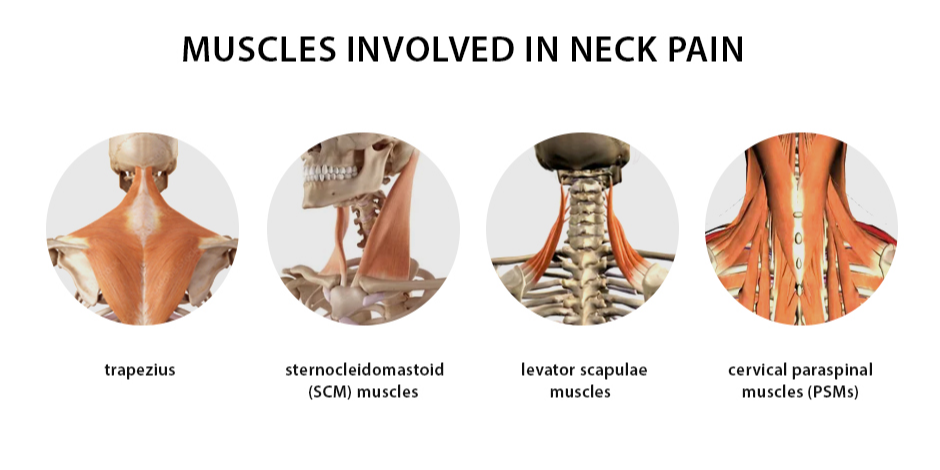
The levator scapulae muscles span from cervical vertebrae C1-C4, and attach at the upper tips of the scapulae (shoulder blades). The sternocleidomastoid and trapezius muscles overlay the levator scapulae, which makes up a portion of the neck’s posterior triangle. The levator scapulae work together with the trapezius and rhomboids to elevate the scapula.
The cervical paraspinal muscles (PSMs) are neck extensors that support the head and stabilize the cervical spine. The cervical multifidus muscle forms the deepest layer of the PSM group. The PSMs can become weakened and cause pain when the neck is perpetually in a head-forward position, as when working on a computer or scrolling a smartphone.
The most common causes of chronic neck pain include:
Poor posture when sitting, standing or walking
Sedentary lifestyle and being out of shape
Chronic stress that causes neck muscle tension
Suboptimal sleeping position
Excessive use of electronic devices
Overuse from sports or exercise
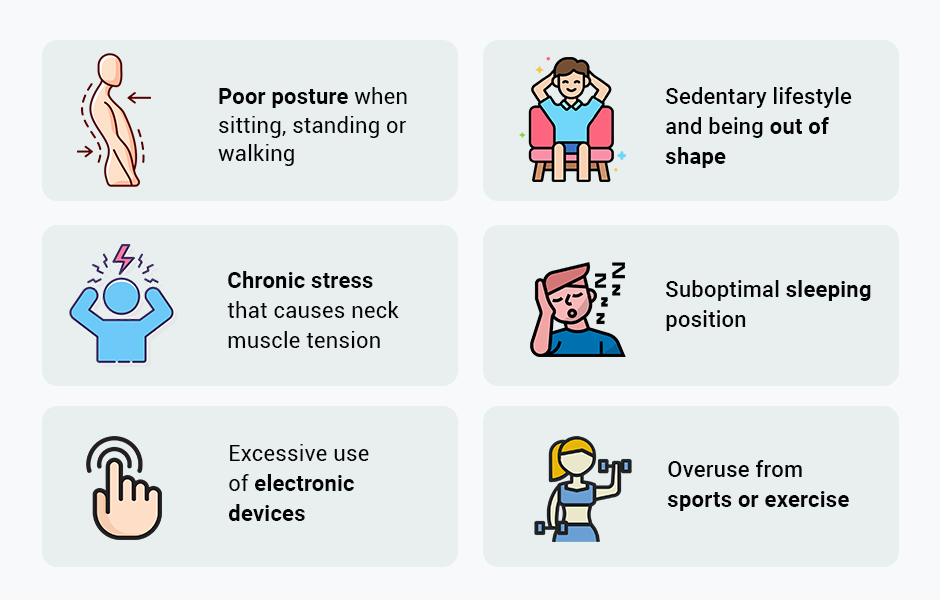
Stretching is often an effective way to relieve neck tension and pain. Try these 5 simple stretches throughout the day when you begin to feel tension in your neck and shoulders.
Sit erect on an office chair or dining chair and grasp the seat near your right hip with your right hand.
Place the fingertips of your left hand just above your right ear.
Inhale, then exhale as you gently pull your head toward your left shoulder as far as it will go.
Slowly rotate your neck to find the tight spots and hold for 5-10 seconds.
Return to your start position and repeat to the other side.
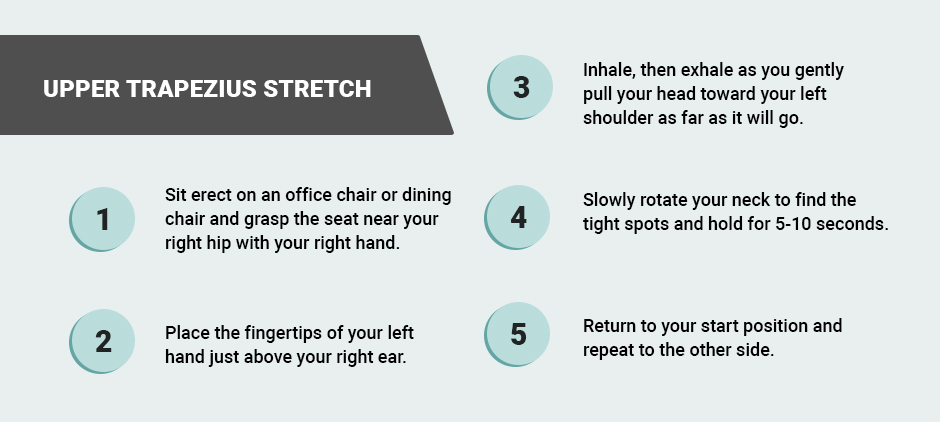
Sit erect on an office chair or dining chair, grasping the chair seat with both hands near your hips.
Inhale, then exhale and slowly drop your chin to your chest, but keep your neck elongated.
Inhale and slowly roll your head to the right until your ear is over your shoulder. Hold for 5-10 seconds.
Exhale and roll your chin back to your chest.
Repeat to the left.
Perform 3-5 repetitions on each side.
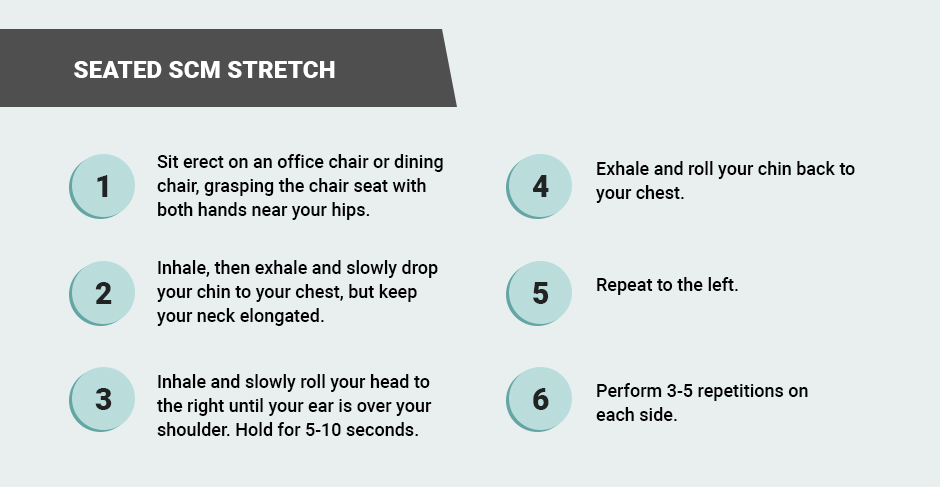
Sit erect on a firm chair, or cross-legged on the floor.
Clasp your hands behind your head at the base of your skull, elbows pointing directly to the sides.
Inhale, then slowly exhale as you roll your head toward your chest, applying light pressure with your hands. Hold for 5-10 seconds.
Slowly rotate your neck to the left, then to the right.
Maintain light resistance with your hands as you inhale and slowly roll up to your start position.
Repeat 3-5 times.
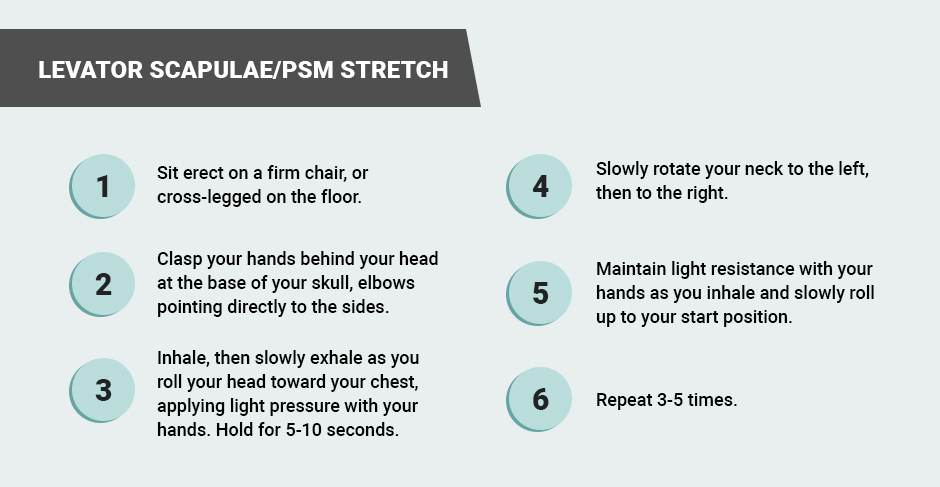
The muscles in your body are all interconnected, and when one area is tight, it can affect your entire body alignment. The muscles of your thoracic spine and rib cage can play into your neck alignment and contribute to neck pain. This stretch will help.
Stand erect, feet hip width, core engaged, chest lifted.
Reach forward with your left arm, palm facing inward.
Without rotating your torso, allow your left shoulder to move forward slightly until you reach the limit of your range of motion (ROM).
Lift your right arm, elbow bent, to shoulder height, and draw it backward as if shooting a bow and arrow.
Hold at the limit of your ROM for 5-10 seconds.
Repeat on the other side.
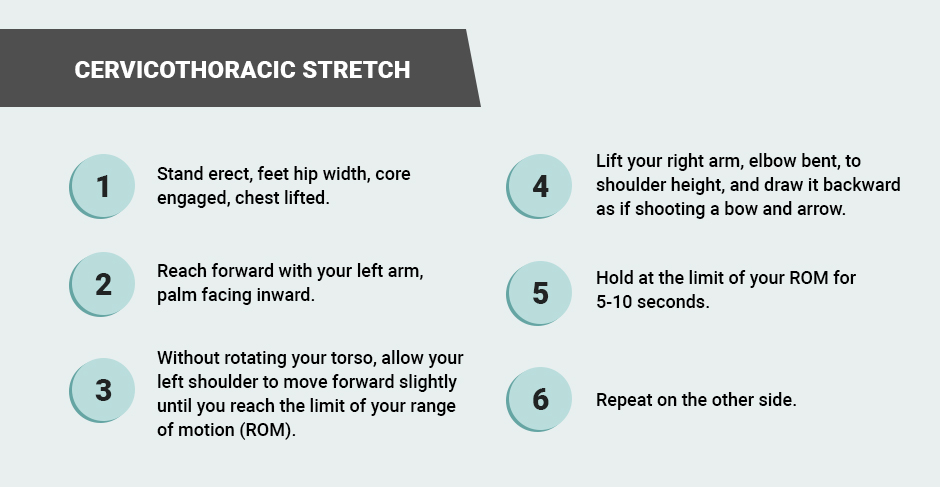
Your chest and shoulders can become tight from sitting at a computer all day, causing your neck and shoulders to round forward. Stretching your chest and shoulder muscles can help to realign your neck and upper spine.
Stand erect, feet hip-width.
Engage your core and lift your chest.
Clasp your hands behind your back and slowly pull them away from your body. Hold for 5-10 seconds.
Hinge forward from your hips to get a deeper stretch.
Slowly return to your start position.
Repeat 3-5 times.
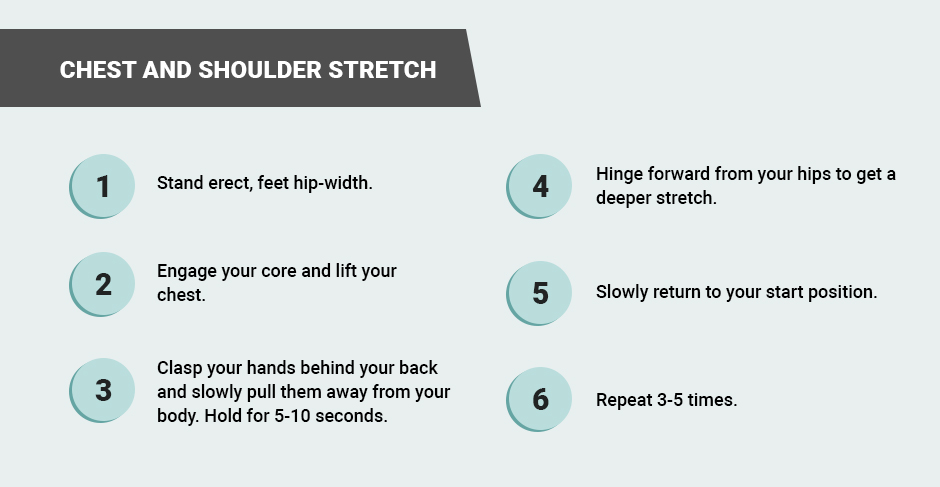
In addition to stretching, tap into these strategies to relieve and prevent neck, shoulder and upper back pain:
Optimize your sleep environment. Poor quality sleep is often at the root of neck pain, and it has also been associated with a number of metabolic health conditions. Purchasing a supportive mattress and an ergonomic pillow will be well worth the investment. You’ll sleep better, feel better throughout the day, and reduce your risk of neck pain.
Take frequent stretch breaks. It’s easy to get so absorbed in your work that you ignore the signals your body is sending you. Set an alarm on your phone or computer for hourly stretch breaks. Get up, walk around, and stretch your neck, back and shoulders. Your body will thank you!
Exercise daily. Regular daily exercise is key to overall good health. You don’t have to go to the gym. A brisk walk before work or during your lunch break will help you stay alert during the day, and you’ll sleep better at night. And walking helps to realign your joints.
Switch up your workstation. Sitting at a desk all day is brutal for your posture, especially in your cervical spine. Consider investing in an adjustable desk that lets you convert to a standing position. Or use a lap desk and switch to a comfy chair with good back and neck support.
See a neck and posture specialist. Working with a chiropractor or physical therapist to correct your posture and realign your neck is a positive step toward good spinal health, now and in the future. Regular tuneups can help you prevent pain and dysfunction, and alleviate neck pain for good.
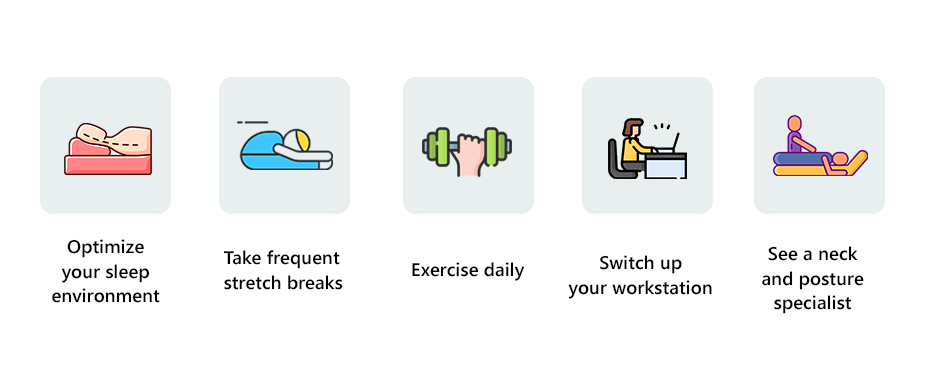
Neck pain should never be ignored. If the above stretches and strategies do not relieve your neck pain, it may be time to see a chiropractor or physical therapist. They will run a battery of diagnostic tests to get to the root cause of your pain and devise an appropriate treatment plan to correct it.
Seeing a specialist early on can save you from disc degeneration, chronic headaches, TMJ syndrome and degenerative disc disease. Early conservative care can spare you from the dangerous side effects of drugs and surgery.
If you suffer from frequent or chronic neck pain, the neck pain specialists at NYDNRehab can help. We use advanced technologies and therapies for neck pain treatment that you won’t find at run-of-the-mill clinics.
Our clinic features:
state-of-the-art diagnostic ultrasonography
extracorporeal shock wave therapy (ESWT)
extracorporeal magneto transduction therapy (EMTT)
manual therapies
physical therapy
posture correction therapy
chiropractic care
and more!
Contact NYNDRehab today, and see why we are the clinic of choice for neck pain relief in NYC.
Resource
Bernal-Utrera, Carlos, et al. “Manual therapy versus therapeutic exercise in non-specific chronic neck pain: a randomized controlled trial.” Trials 21.1 (2020): 1-10.
Navarro-Santana, Marcos J., et al. “Effectiveness of dry needling for myofascial trigger points associated with neck pain symptoms: An updated systematic review and meta-analysis.” Journal of clinical medicine 9.10 (2020): 3300.
Dr. Lev Kalika is a world-recognized expert in musculoskeletal medicine. with 20+ years of clinical experience in diagnostic musculoskeletal ultrasonography, rehabilitative sports medicine and conservative orthopedics. In addition to operating his clinical practice in Manhattan, he regularly publishes peer-reviewed research on ultrasound-guided therapies and procedures. He serves as a peer reviewer for Springer Nature.
Dr. Kalika is an esteemed member of multiple professional organizations, including: